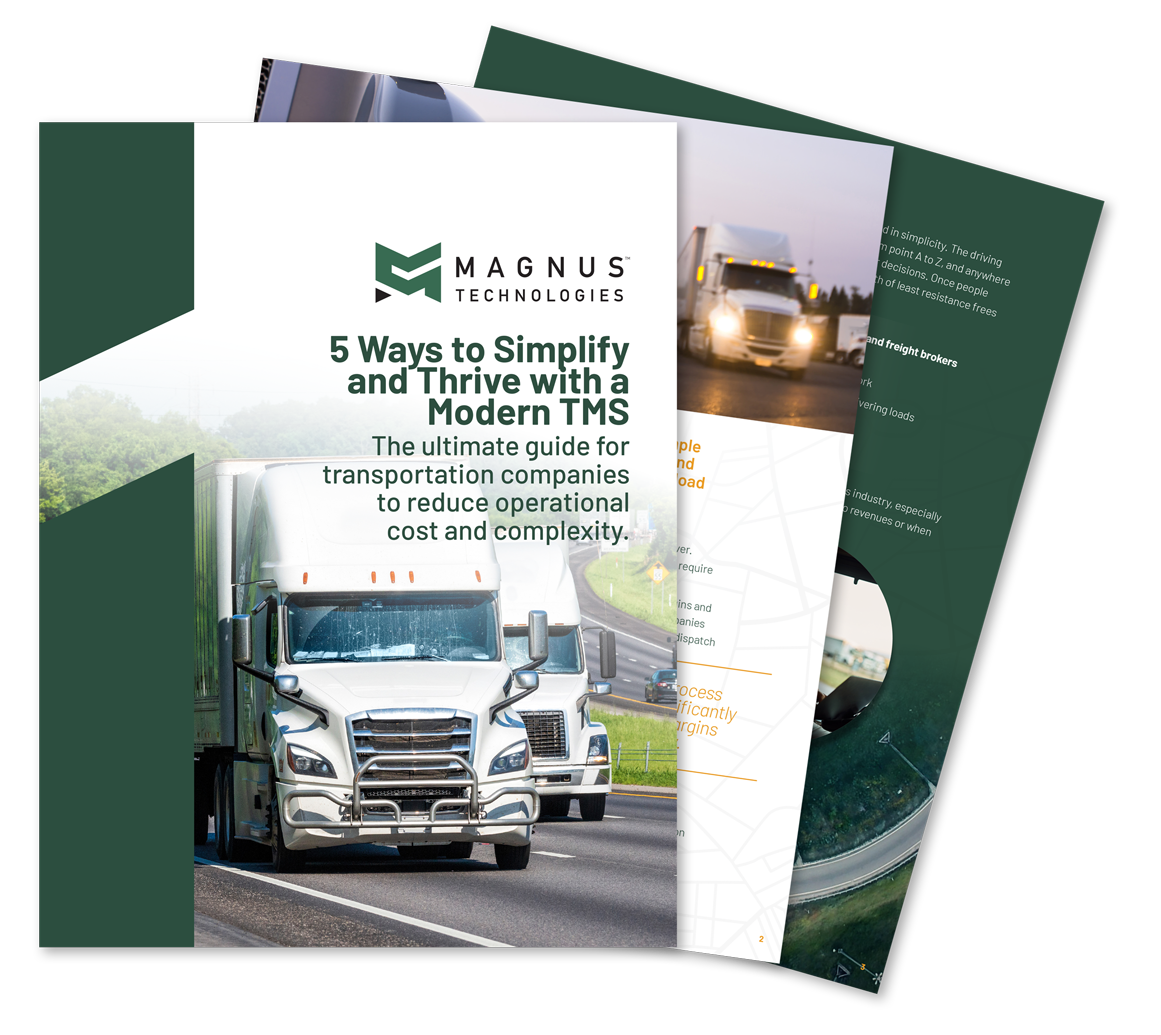Top 12 Reasons to Invest in a TMS
As technology continues to proliferate across the supply chain, transportation companies are expected to deliver greater visibility for all of the steps in freight transactions.
Investing in a TMS that can simplify your operations will make this possible by enabling you to more effectively manage and share information with all stakeholders.
Discover the top 12 benefits you can expect by investing in a modern TMS.
Choose your section:
-
Why Invest in a Modern TMS?
-
Top 12 Reasons to Invest in a Cloud-Based TMS
- Simplify Operations
- Increase Driver Retention
- Expand Customer Base and Diversity
- Improve End-to-End Visibility
- Manage Costs More Effectively
- Improve Business Process and Automation
- Increase Agility
- Offer Better Customer Service
- Enhance Decision-Making
- Drive Innovation
- Improve Compliance & Risk Management
- Enrich Customer Relationships
-
Accelerate ROI with a cloud-based TMS
Why Invest in a Modern TMS?
The COVID-19 pandemic accelerated the digitization of supply chains. Transportation companies had to implement new technology quickly to solve new challenges and meet increased customer demand. Freight visibility became table stakes from shippers expecting near real-time ETAs for shipments. These and other challenges are being solved by using a modern transportation management system (TMS) to simplify operations.
“Any company that was previously using a combination of analog (e.g., spreadsheets and clipboards) and digital (software, Cloud, AI) processes to run their supply chains quickly stepped up their investment to offset the business impacts of the pandemic,” noted Bart De Muynck, research vice president, transportation technology at Gartner, in the 2021 Gartner study on TMS.
That study found significant growth in the TMS market. Cloud-based solutions, like Magnus TMS, can offer the fastest, most cost-effective implementations and easiest user experience.
Investing in a modern TMS can deliver many benefits like greater efficiencies and improving supplier and partner relationships. In fact, a survey by Peerless Research Group found that half of TMS users achieve a return on investment within 12 months.
Below are the Top 12 reasons to invest in a cloud-based TMS to simplify your business.
Not sure if you need to upgrade your TMS?
Look for these 3 warning signs.
Top 12 Reasons to Invest in a Cloud-Based TMS
1. Simplify Operations
Sticking with the status quo often keeps trucking companies from implementing next-generation technology to save significant time and money.
Identifying the best-fit technology for your business is the first step. Tools that create more efficient processes and more transparency contribute to better decision making.
For instance, a modern, cloud-based TMS that simplifies your operations will eliminate manual steps in rating, load planning and driver payroll, among other routine tasks, to fully digitize your quote-to-cash process for loads.
2. Increase Driver Retention
Driver turnover has far-reaching impacts on cost, customer service, and safety. A modern TMS can also remove uncertainty for drivers to improve retention.
Fleets can maximize driver productivity and satisfaction by using a driver-centric mobile app that is native to their TMS. Drivers can access features that go beyond pickup and delivery tasks, such as viewing pay for upcoming loads and requesting time off.
A native mobile app extends the power of automation to drivers, in and outside the cab. Key characteristics of a fully integrated mobile dispatch system include:
- Route assignments. Loads dispatched to drivers are visible in the app. Drivers also see deadhead and true loaded miles, among other load details.
- Load tracking. The driver can update the status of the order at the critical steps along the route.
- Instant two-way messaging. Dispatchers can use the TMS to exchange messages with drivers via email, text, or directly to the app.
- Electronic document capture. Drivers are prompted to capture proof-of-delivery receipts through the app and cannot submit loads for payroll until this step is complete. Fleets can also use signature capture for a true electronic delivery.
Make the most of real-time driver connectivity.
Click here to see how a fully integrated mobile app works.
3. Expand Customer Base and Diversity
During periods of economic growth, carriers and freight brokers have ample opportunities to increase business with existing customers. Yet growth-focused strategies that do not break the mold could backfire when markets shift. Experience shows that diversifying your customer base will make it easier to shift resources when one market suffers more than others. Trucking and logistics companies that use a full-featured, modern TMS can enter new markets without creating more work and complexity. Having a TMS that can handle diversified operations – such as refrigerated, flatbed, dry van, auto hauling, brokerage and more – can also help improve driver retention and asset utilization.
4. Improve End-to-End Visibility
The ability to track a load from the manufacturer to its final destination is a non-negotiable part of supply chain strategies.
Most Electronic Logging Device (ELD) systems provide GPS tracking data for loads but leave visibility gaps that must be filled by a TMS, such as pickup and delivery schedules for tracking on-time performance for arrivals and to capture the proper load documentation. A cloud-based TMS does this and more by tracking the execution of a load according to plan and monitoring for exceptions as conditions change.
5. Manage Costs More Effectively
Understanding all parts of your business is vital. Without technology, estimating, budgeting, and controlling costs are time-consuming processes and prone to error. To keep expenses in check, a TMS needs to integrate with accounting and payroll systems, ELDs and other third-party applications.
Get more bang for your buck. Click here to discover the benefits of a next-gen TMS pricing model.
A TMS is the heart of your operations. As such it must have the ability to connect, share, and coordinate various activities. A modern TMS can provide real-time insights for cost management and other important areas.
Price Comparison: Which is more cost-effective – a modern TMS or on-premises model?
6. Expand Business Process Outcomes
With the right technology, companies can more quickly adapt to needs and opportunities in the marketplace. Cloud-based technology makes it easy to stay current, especially when system updates from vendors are available at no extra cost. Staying current will ensure you have the latest tools to simplify processes and protect your data.
Additionally, a TMS’s latest reporting and analytics tools will remove bottlenecks and provide insights to proactively improve outcomes.
7. Increase Business Process Agility
A modern TMS will identify exceptions that occur during any step of the quote-to-cash process for loads to control costs and outperform the competition by identifying and responding to new business and market trends.
Implementing a TMS that provides real-time visibility, transparency, and accountability for all processes of the load lifecycle will enable you to operate in a more agile fashion.
8. Better Service Your Customers
Clear and responsive communication is the key to managing customer relationships.
Keeping the channels of communication open is where a modern TMS works best. Having a native mobile driver app can provide you and your customers with real-time shipment updates and help you proactively address critical service issues.
Shippers want to partner with companies that invest in solutions to create more transparency and simplify their customer experience.
Uncover 3 ways a modern TMS helps enhance your ability to serve customers.
9. Enhance Decision-Making
Dashboards make information accessible across the entire lifecycle of a load by tailoring views according to user responsibilities. A cloud-based TMS that gives users transparency of results – with the ability to drill down to see transaction-level details – can greatly simplify work and empower better decision-making
10. Drive Innovation
Investing in a modern TMS is an essential strategy to keep up with market demands. As the “hub” of a trucking company’s technology wheel, a TMS must be able to easily connect, share, and coordinate activities.
11. Improve Compliance & Risk Management
A holistic approach for managing compliance and risk is made possible with an enterprise-wide TMS solution that tracks, compiles, analyzes, and shares essential data to reduce risk (and costs) while enhancing the customer experience.
The right combination of technology and best practices will simplify your compliance and risk management processes to stay ahead of trends.
Find out if your TMS passes the stress test with this free download.
12. Enrich Customer Relationships
Communicating regularly and effectively with your suppliers and partners is the foundation for building relationships of trust. Automatically providing customers regular updates for rates, capacity, load acceptance, shipment ETAs and many other data points will provide maximum transparency and close the loop for routine communications.
Leveraging technology to automate these and other tasks will eliminate miscues and make everyone more efficient.
Accelerate ROI with a cloud-based TMS
A cloud-based TMS will ensure you always have the latest updates and system integrations to maximize productivity and efficiency for office staff and drivers.
Selecting a TMS that integrates with all parts of your business, and simplifies processes by using intelligent automation and end-to-end visibility tools will deliver the fastest return on investment.
Still not sure? Here’s the top five areas carriers need to consider when deciding to stick with their proprietary TMS or switch to a cloud-based TMS provider.




